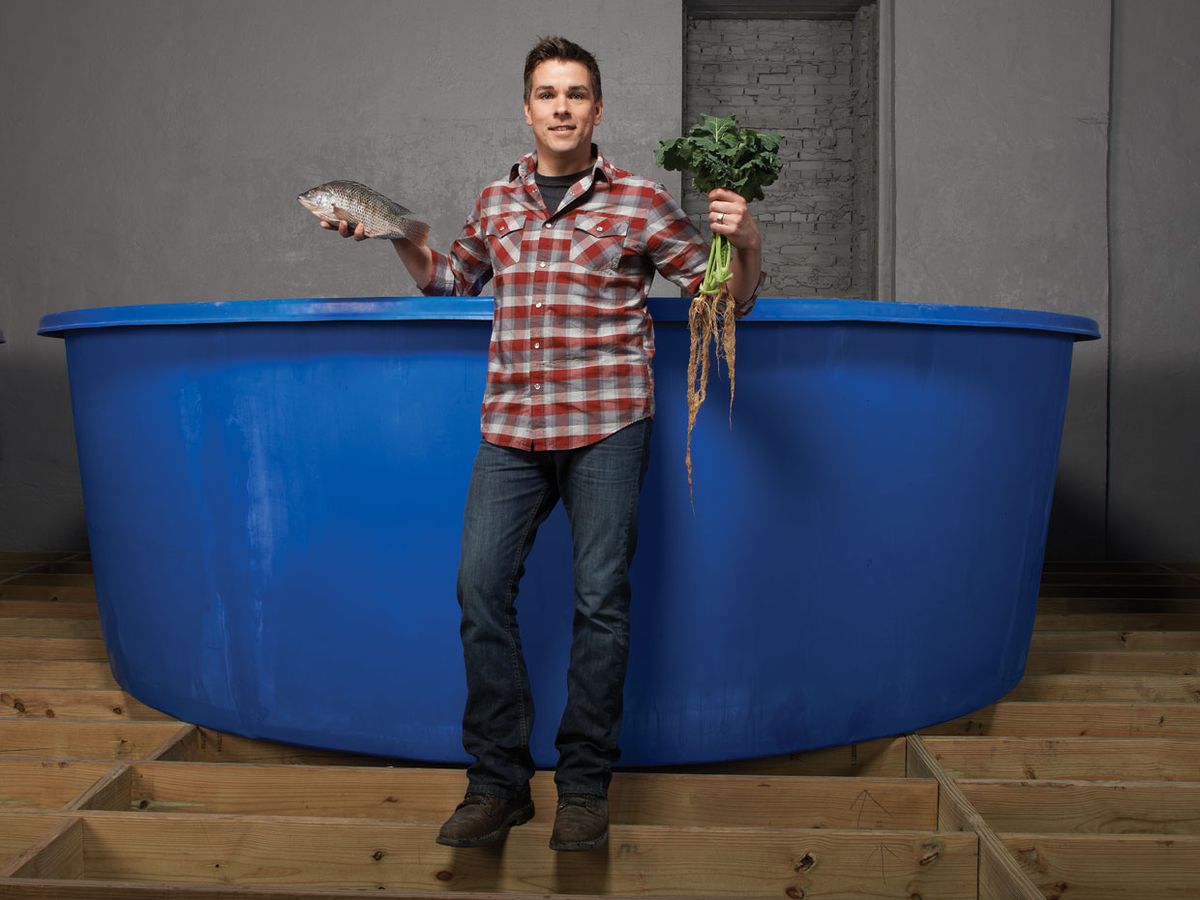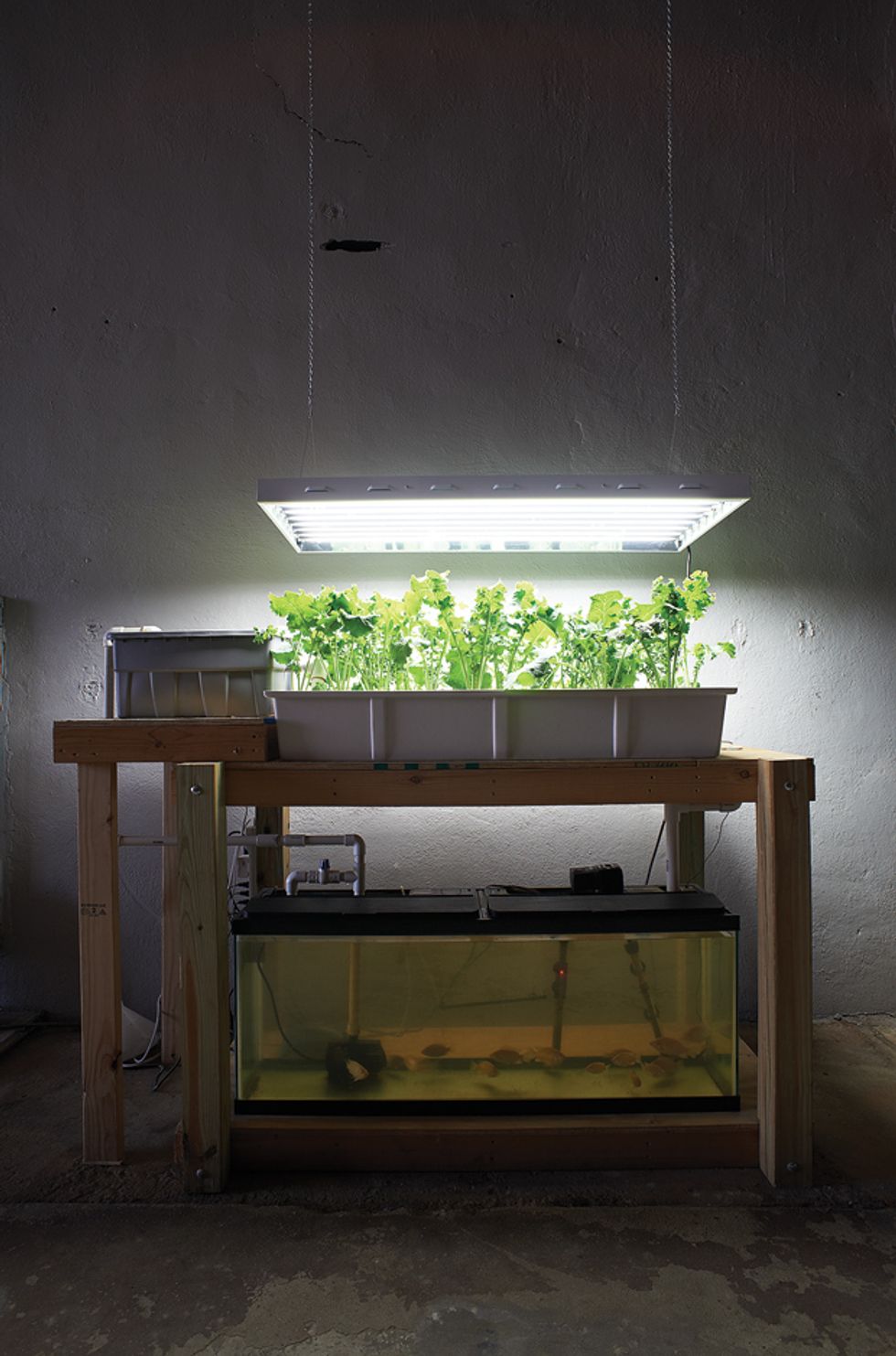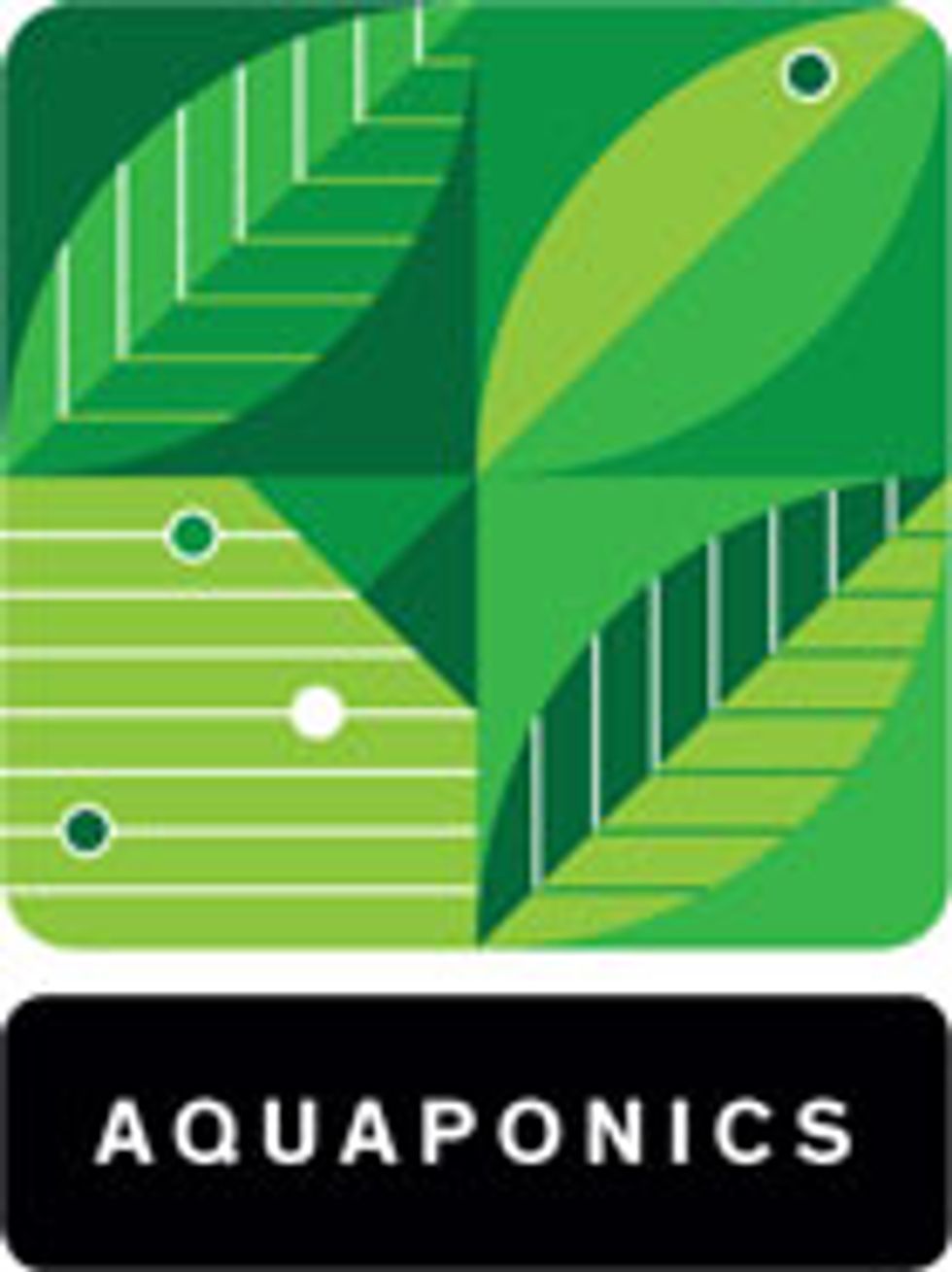The Indoor Aquaponics Farm
Urban Organics plans to grow fish, greens, and maybe the whole indoor aquaponics industry

The old Hamm’s brewery looms over the gritty East Side of St. Paul, Minn., a redbrick citadel of suds that rolled out its last barrel in 1997 and then became a 3-hectare site for urban explorers to shoot trophy pictures and for graffiti artists to showcase their mad skillz.
But beyond the busted windows and spray-painted tags, business partners Chris Ames, Fred Haberman, and David and Kristen Haider of Urban Organics see an indoor farm. Using a hybrid farming method called aquaponics, which combines aquaculture (fish farming) and hydroponics (growing plants in water), this massive, 4700-square-meter indoor field of greens will feed thousands of fish and be fertilized by the resulting fish poop. Nothing will go to waste.
Commercial aquaponics has been conducted mostly in warm places such as Australia, Hawaii, and the U.S. Virgin Islands. But with consumers increasingly interested in locally and sustainably grown organic food, the idea seems poised to take off in colder climates—indoors. The concept seems especially appealing in the upper Midwest of the United States, which has a surfeit of abandoned industrial buildings, a short growing season for high-value, highly perishable crops like arugula, baby lettuces, herbs, and microgreens, and an overburdened Great Lakes fishery. Large indoor aquaponics farms such as The Plant and FarmedHere in Chicago and Sweet Water Organics in Milwaukee have sprung up in the last five years.
“There’s an intellectual current coming from people who are becoming very concerned that we’ve got to do something about global warming and food security,” says James Godsil, who founded the Sweet Water Organics indoor aquaponics farm in Milwaukee in 2008 with Josh Fraundorf and Steve Lindner. Godsil adds that growing food close to consumers so they can get to know their farmers is a key part of an emerging culture that he calls “the Arugula Nation.”
With US $300 000 in grants and loans from the city of St. Paul, and another $1 million from private backers, Urban Organics started construction in Hamm’s century-old Stock House #3 in late 2012. Using a system designed in collaboration with Pentair Aquatic Eco-Systems (PAES) of Apopka, Fla., Urban Organics expects to harvest 450 000 kilograms of lettuces and fresh herbs and up to 23 000 kg of fish per year by 2014. That would make it one of the world’s largest commercial indoor aquaponics facilities.
“Right now, Minnesota imports tilapia from places like China and Honduras and lettuce from California and Mexico,” says David Haider, a trim 37-year-old who ran a landscaping business for nine years before taking on the Urban Organics project full time. “This gives us the opportunity to grow it year round and keep it local.”

But so far, no one in the Arugula Nation has managed to build a large, indoor aquaponics farm that can break even, much less turn a profit. If the Urban Organics team succeeds, it will be because they learned from the mistakes of others.
Over lunch at an East Side bistro where the only greens on the table are three limp leaves of arugula in my Brie panino, Haider recalls that his friend Ames, who’s sitting beside him, thought he was crazy when he first brought up the idea of an indoor aquaponics farm two years ago.
“I said, I think I have an idea to solve world hunger. You know, everyone sort of gives you that look like, ‘Here we go, I’ve heard this before,’ ” says Haider, rolling his eyes and sharing a laugh with Ames before turning serious again. “We obviously can’t do it from just this site, but we’re hoping to show that it can be done and that it could be replicated in other cities.”
In creating a model for others, the Urban Organics team at first took their cues from Sweet Water Organics and from Will Allen, another Milwaukee urban farmer, who outlined his own aquaponics system in his book The Good Food Revolution (Penguin, 2012) and has since shown it off at Growing Power, his model farm.
However, the founders of Sweet Water Organics just couldn’t make Allen’s system work, at least not on the scale they’d intended. And indeed, when I went to visit Sweet Water this past February, the building that had once been an aquaponics landmark was now dark, empty, and for sale. The stock of fish, which once stood at 15 000, had dwindled to 396. A couple of small demonstration fish tanks burbled quietly in one corner, lonely vestiges of the lush green farm that TV foodie Andrew Zimmern visited for his “Appetite for Life” Internet show just a few months before. A new fish house and the greenhouses next to it are where Sweet Water hopes to raise greens and rise again.
What went wrong the first time around? Mark Haase, who’s engineering the new process, says that the Sweet Water team had taken the original building’s built-in sunken railroad bed, partitioned it into rectangular tanks, and lined them with sheets of synthetic rubber, much like the setup Allen describes in his book. A two-tier wooden rack system lit by T5 fluorescent bulbs held long trays filled with water that sat above the tanks. Polystyrene rafts perforated with holes that cradled seedlings were placed on top of the water, which was pumped up from the fish tanks. The plants absorbed nutrients from the water, which flowed back down to the tanks.
If you’ve ever tried to keep a tank of tropical fish clean, you might guess what happened next. Fish excrement collected in the corners and fouled the rafts. “One of the drawbacks of the Will Allen system,” Haase explained during a tour, is that “the sump pumps are right in the fish tanks. Those pumps are grinding up the solids and suspending them, and that makes it harder to filter out.”
The system was also overcrowded. Fifteen thousand fish in a 34 000-liter system might have seemed like a recipe for commercial success at first, but it was ultimately unsustainable. Scores of fish died or had to be destroyed, some suffering “inflamed gills, friable livers, and distended gall bladders,” according to an investigative article in the Bayview Compass, a local weekly. Most of the employees, a number of whom had gone without pay for weeks, left.
After the exodus, the task of reviving the operation fell to Haase, who has an undergraduate degree in limnology (the study of inland waters) and 25 years of experience in industrial wastewater treatment and environmental monitoring. Having inherited parts of a new system designed by Charlie Price of Aquaponics U.K., Haase googled around and came upon the work of the man widely regarded as the father of modern aquaponics: James Rakocy, yet another Milwaukee native, who’d spent 30 years perfecting a commercial-scale aquaponics farm at the University of the Virgin Islands, and who at one point had Charlie Price as a student.
Haase is now tweaking Price’s design according to Rakocy’s setup: an insulated fish house where water from the sump gets pumped up into two 4500-liter fish tanks and then drains out again through a filter to the greenhouses. Then it goes back again to the sump.
“The cleanest water in the system is the sump, and that goes to the fish tanks,” Haase points out.
Coming November 2013: Surf and Turf: The Growth of Aquaponics in St. Paul, an IEEE Spectrum documentary.
“I could have told [Sweet Water] from the Virgin Islands that [they were] on the wrong track,” Rakocy said when I reached him via Skype at his home in Pattaya, Thailand, where he retired in 2010.
“For one thing, we don’t use square tanks because it makes it hard to remove solids,” he said with the exasperated air of someone who has seen too many aquaculture operations botched by amateurs. “They never even had a mechanism to remove the solids, so they let the waste accumulate on the bottom of the tank, which starts to decompose and give off ammonia, take up more oxygen, and give off other toxic gases, like hydrogen sulfide.”
450 000 kilograms
That’s how much lettuce and fresh herbs Urban Organics expects to harvest by 2014, along with 23 000 kg of fish per year.
35 days
How long it takes for a head of lettuce to mature in an aquaponics system versus 50 days for lettuce planted in soil.
The aquaponics world is small, and even in retirement Rakocy is at the center of it, traveling widely to conduct workshops. In March he spoke in Abu Dhabi with Thomas Losordo, PAES’s aquaculture expert and one of his coauthors on the seminal article about aquaponics. Twice a year, Rakocy teaches a class for PAES in Florida. It’s no wonder then that Rakocy has recently taken a keen interest in the St. Paul project.
He is, however, concerned about the prospects for urban indoor aquaponics. He points out that the rules and regulations against farming in an urban setting, which vary from city to city, can be expensive and time-consuming to comply with.
Ventilation is also an issue. “Aquaponic systems put out a huge amount of water vapor, and these warehouses aren’t built for that moisture load,” Rakocy says, adding that carbon dioxide can also build up indoors. “I think they’re taking that into account at the Hamm’s brewery.”
Haider confirms that each floor in Stock House #3 will have five ceiling fans to circulate the air, plus two ventilation fans, one each on the north and south walls. And heat pumps will capture the latent heat in the humid ambient air and transfer it back into the fish tanks, reducing the humidity substantially.
Then there’s the cost of powering the pumps, filters, and especially the fluorescent lighting, which combined will tally $5000 to $8000 per month. Rakocy points out that greenhouse-based aquaponics operations don’t have lighting costs, relying instead on natural sunlight.
But there are countervailing benefits from farming indoors under the lights, argues the Urban Organics team. Growth continues around the clock, 365 days a year. Crops are not exposed to harsh weather conditions. And plants grow faster in an aquaponics system than on a conventional farm—much faster.
“The roots can remain small because the nutrients are everywhere, so the plants grow faster,” says Huy Tran, PAES’s plant expert. “A head of lettuce planted in soil takes 50 days to mature. One in an aquaponics system takes 35 days or so.” The flow of water and nutrients through the system can be tightly controlled, allowing Urban Organics to vary production according to market demand.
Finally, there’s the advantage of growing food practically down the street from the consumer. While the fish will provide some revenue, it’s the high-value greens such as arugula, baby lettuces, and microgreens and fresh herbs like basil that Urban Organics is counting on to make its real money.
According to agricultural economist David Weatherspoon of Michigan State University, a successful business model for indoor aquaponics depends in part on the proximity of the farm to the tables where its produce will be eaten. Being able to harvest produce in the morning so chefs can have it on lunch plates that afternoon is, Weatherspoon admits, “a good marketing point for the leafy vegetables. And that might be where the sweet spot is.”
The first time I visited Urban Organics last September, Haider showed me one of the aquaponics systems that he had originally set up in his basement. A polystyrene raft full of lettuce seedlings floated in a tank, with a few tilapia swimming below and a fluorescent bulb glowing from above.
He took me through the first two floors, showing me how they’d been completely gutted and repainted. Now they were empty, except for some massive, 5.5-meter-tall load-bearing columns and eight big blue tanks placed at even intervals on each floor.
Haider and his partners already knew what crops and fish they wanted to grow—tilapia and greens. They also knew exactly which markets they would serve. They had distributors lined up for their fish and produce and were working on deals to supply various restaurants as well as the St. Paul and Minneapolis public schools. But the systems design for the farm was still a work in progress when PAES came calling last November.
“We were following news stories, and we reached out to Dave Haider and Fred Haberman,” says Bob Miller, PAES’s vice president for aquaculture. “We had lunch together up in St. Paul and talked about what we could bring to the table in terms of design services and equipment and founded the relationship off that visit.”
The Urban Organics team—led by Losordo on the aquaculture side and Tran and Haider on the plant side—took the Rakocy system and added a few high-tech wrinkles to optimize fish health and plant growth in an indoor environment. The setup’s also designed to allow the fish and plant sides to operate independently should one part have to go off line.
To get a picture of how the system will work, just follow the water. It starts in 13 200-liter fish tanks (circular and self-cleaning), each containing 1000 to 2000 tilapia that feed on a high-protein soy mixture. Next, it drains under gravity into a radial flow separator, where the solid waste—fish poop and uneaten food—gets filtered away in stages. First the heavier stuff settles and is shunted to a wastewater treatment system in the basement; then the remaining water is filtered through a screened drum, which catches the larger particles and releases them for treatment when rinsed.
What’s left is clarified water, which drains via gravity to a fiberglass tank about the size of a Volkswagen Beetle. In this tank, called a moving-bed biofilter, a blower aerates the water, removing carbon dioxide and adding oxygen to the water so that the biological filtering can work.
Thousands of plastic paddle wheels small enough to fit in the palm of your hand accommodate two kinds of helpful bacteria, which cover the surfaces in a thin film. As the water flows over this biofilm, the first kind—Nitrosomonas—converts ammonia from fish waste into nitrites, and the second kind—Nitrobacter—breaks down the nitrites into nitrates, which are relatively nontoxic to fish and good food for plants.
A constant-flow pump sends that nutrient-rich water to the plants, and two others pump water back to the fish tanks. Each of them has a permanent-magnet motor and an integrated variable-speed controller to let the system speed up or slow down, keeping the flow rate constant despite changes in pressure. By pumping no more than is necessary, Losordo says, this technology can save a lot of money.
The plants float on polystyrene rafts in 18.3- by 1.2-meter plastic troughs, arranged in three tiers on a rack, and on six to eight racks—with up to 24 000 plants—per floor. The plants are anchored in their holes by plugs of coconut husk fiber called coir, their roots dangling in the water flowing from the biofilter, which is pumped to the end of the rack furthest away from the fish tank and injected at each tier, ensuring that each level gets the same concentration of nutrients.
Each stratum of plants will be lit with twenty 250-watt T5s suspended about half a meter above the plants, for a total of 300 bulbs per floor. While LED grow lights are the holy grail for efficiency, their high cost puts them out of reach for all but small research projects and marijuana growers. For the leafy greens that Urban Organics is going to grow, Haider and Tran say the T5s will do just fine.
After delivering nutrients to the plants, the water flows back down to the drum screen and moving bed filter, which remove stray leaves and strands of coir; then it’s pumped back up to the fish tanks. A monitoring and control system keeps an eye on pH level, temperature, conductivity, and oxygen levels in each tank.
The system PAES is building with Urban Organics differs from others I visited, not only in its hydraulic wizardry but also in its decision not to dole out just enough nutrients to feed the plants.
“Instead of two fish tanks per rack system, Urban Organics is going to install five tanks per floor, so they actually have more nutrients than they need, but they’ll also be producing more fish than they would have otherwise,” Losordo explains.
That’s why excess nutrients—about 5 percent of the water and waste flowing through the system each day—end up in the wastewater treatment system in the basement. The company plans to use the sludge as compost for growing mushrooms in the basement and to treat the water to convert its nitrates into nitrogen gas, which it will vent from the building. It will discharge the treated water into the municipal sewer.
The treatment system wasn’t installed when I visited Urban Organics on a brutally frigid day in mid-March. But other parts of the farm had come a long way since my last visit just a few weeks prior.
Massive wooden frames had been put in place for windows where there had once been only giant holes in the redbrick walls. On the first floor, four fish tanks sat atop a large platform, and six enormous racks with three tiers of wooden runs were being wired for electricity. The drum screen filter—Losordo had insisted upon the large version—had just arrived and sat in a corner with other filtration devices still in their shrink-wrapped boxes. Haider talked with an insurance agent while workers rocked out to Van Halen and banged supports into place.
In a matter of weeks, water will be flowing and fish will be growing and by November, green plants will reach to the ceiling. That’s the plan, anyway, one backed by a big company eager to expand the market for its goods and services. And that gives Haider and his partners a fighting chance to pull off an indoor aquaponics farm that could make a real difference in this community, and beyond.
This article originally appeared in print as “The Indoor Farm.”

